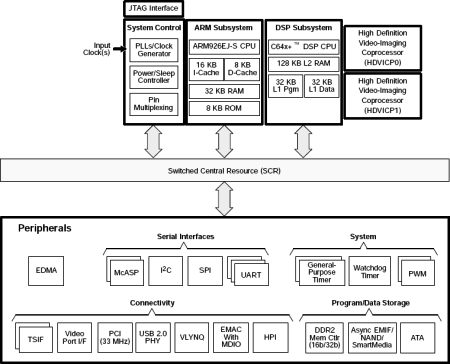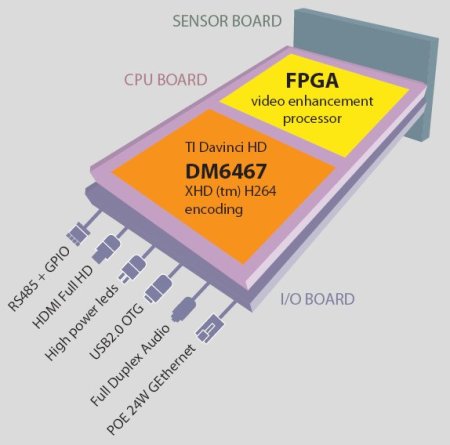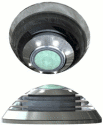HD surveillance camera design runs homespun Linux
Jun 23, 2008 — by Eric Brown — from the LinuxDevices Archive — 10 views Marseilles, France-based Nexvision has announced a network IP (Internet protocol) video camera design that incorporates the Texas Instruments (TI) DaVinci TMS320DM6467 processor. The Linux-based CamHD hardware/software reference design is equipped with an Altera Cyclone III FPGA (field-programmable gate array), and boasts a… claimed 1080P HD resolution.
Marseilles, France-based Nexvision has announced a network IP (Internet protocol) video camera design that incorporates the Texas Instruments (TI) DaVinci TMS320DM6467 processor. The Linux-based CamHD hardware/software reference design is equipped with an Altera Cyclone III FPGA (field-programmable gate array), and boasts a… claimed 1080P HD resolution.
(Click for larger view of the CamHD reference design)
The Nexvision CamHD offers 30 frames per second (fps) HD video using the H264-MP codec, claims Nexvision. It is said to support either full 1080P (2 megapixels at 30fps) or X-HD (5 megapixels at 12fps, or 8 megapixels at 7fps). The CamHD also supports HDMI output and Power-over-Ethernet (PoE) operation.
Announced in December, TI's media-savvy TMS320DM6467 system-on-chip (SoC) combines a 297MHz ARM9 core with a 600MHz C64+ digital signal processor (DSP). The single-chip, 90nm-process SoC tunes core DaVinci DSP functions to the task of HD transcoding, says TI. For example, it can translate between video codecs, bit rates, and resolutions, as video is moved between different devices on home media networks, TI claims.

TI DM6467 block diagram
(Click to enlarge)
The on-board Altera Cyclone III FPGA is equipped with two DDR2 SDRAM banks. The FPGA is dedicated to 3D video enhancement and a picture noise reduction algorithm that is said to incorporate Nexvision IP (intellectual property).
The reference design offers a 110 megapixels per second processing pipeline, 12-bit color exposition, and 3D temporal filtering and contrast enhancement, says Nexvision. Other features include touted support for motion JPEG, multiple exposure blending, and “super resolution over multiple video sensor acquisition.” The CamHD provides full-duplex audio, and is said to offer support for both immersive and partial views.

Simplified block diagram of CamHD
(Click to enlarge)
The DM6467 is available with a development board and software stack based on MontaVista Linux, but Nexvision appears to use a homegrown Linux distribution instead. The CamHD comes with an onboard streaming server, as well as an optional onboard video analysis framework for automated video surveillance. The framework is said to support motion detection, fire detection, traffic surveillance, automatic number plate recognition (ANPR), intelligent behavior recognition, and other surveillance tasks.
The CamHD ships with remote management software that is said to be compatible with any H264 RTP/RTSP compliant client, including Nexvision's own NexRMC (Nexvision Remote Media Center) software. NexRMC supports CamHD-specific features such as X-HDTM resolution, sensor monitoring, firewall pass-through, and video content search, says the company.
Hardware specs for the CamHD include:
- Processor — TI DaVinciTMS320DM6467 SoC
- FPGA — Altera Cyclone III
- Memory — 128MB DDR2 SDRAM (up to 256MB); 16MB NOR flash (upgradeable to 64MB)
- Ethernet — 1 x gigabit Ethernet
- WiFi — 802.11n (optional)
- USB — 1 x USB 2.0
- Other I/O:
- RS232 (RX/TX) plus RS485 (half-duplex)
- I2C and SPI bus
- RS232/JTAG
- 2 x opto-coupled input
- 2 x general purposes on/off switch
- 1 x switch button
- HDMI 1.3/DVI 1.0 compliant with 19-pin connector
- RS232 (RX/TX) plus RS485 (half-duplex)
- Audio — 3W speaker; Line Out; microphone; stereo Line In
- CMOS image sensor — progressive scan (color) with 2, 3, 5, or 10 megapixels and 1V/Lux-sec sensitivity; optional dual sensor with lower resolution and ultra high sensitivity, or monochrome sensor
- Lens — 60- to 185-degree field of view with C/CS or M12xP0.5mm thread diameter
- Other features — web-based remote management, configuration, and viewer application; third-party accessible video analysis framework
- Power — 12VDC up to 40VDC (support for 24VAC); 30W (20W for PowerLED lighting); Power over Ethernet Plus (802.3af/pre-802.3at)
- Dimensions — 3.7 x 2.4 x 1.6 inches (93 x 60 x 40 mm)
- Operating temperature — 32 to 122 degrees F (0 to 50 degrees C)
- Operating system — homegrown Linux 2.6; U-boot; TFTP image downloading to NOR flash; Glibc/busybox; multiple-path video processing pipeline (GStreamer-based)
 Nexvision's Nexdome Dragonfly (Click for details) |
Availability
Nexvision did not provide any details on the pricing or availability of the CamHD reference design.
Two years ago, Nexvision announced a network video security camera prototype called the Nexdome Dragonfly that was based on TI's DM644x-series DaVinci SoCs.
This article was originally published on LinuxDevices.com and has been donated to the open source community by QuinStreet Inc. Please visit LinuxToday.com for up-to-date news and articles about Linux and open source.